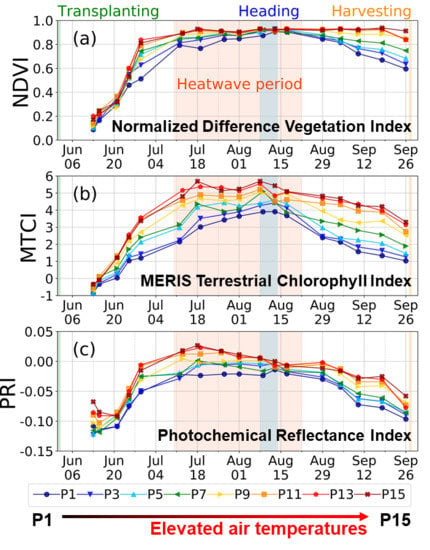Performances of Vegetation Indices on Paddy Rice at Elevated Air Temperature, Heat Stress, and Herbicide Damage
Abstract
1. Introduction
2. Data and Methodology
2.1. Study Area and Cultivation
2.2. Measurement Data
2.2.1. Meteorological Data
2.2.2. Ground Measurements of Growth Parameters
2.2.3. Optical Measurements for Vegetation Indices
3. Results and Discussion
3.1. Time Series of NDVI, MTCI, and PRI Under Elevated Air Temperature
3.2. Performance of PRI Under the Heat Stress
3.3. Performance of Vegetation Indices Under the Abnormal Growth
3.3.1. Relationship between Cumulative Growing Degree Days and Plant Height
3.3.2. Relationship Between Plant Height and Vegetation Indices
3.3.3. Relationship between Leaf Area Index and Vegetation Indices
3.3.4. Relationship between Above-Ground Dry Matter and Vegetation Indices
3.3.5. Relationship Between Cumulative Growing Degree Days and Vegetation Indices
3.4. Estimation of Grain Yield Using Vegetation Indices
4. Conclusions
- (1)
- The cumulative GDD had a stable relationship with the plant height and LAI under normal growth conditions;
- (2)
- The relationship between vegetation indices and growth parameters such as plant height, LAI, and AGDM was constant regardless of abnormal growth data until the heading stage. This means that vegetation indices can replace growth parameters;
- (3)
- The structural vegetation index, i.e., NDVI, can detect the slow growth and development of the crop caused by stress using the relationship with cumulative GDD. This concept can explain the abnormal condition of the crop, even if measurement data for several decades is not available;
- (4)
- PRI is the most useful vegetation index under physiological stress caused by heat stress. Unlike other vegetation indices, PRI decreased under the extremely high air temperatures even before the heading stage. When PRI decreases before the heading stage, this phenomenon might be the effect of the physiological stress and can then take the following actions: (1) Put silicate and potassium fertilizer; (2) let heatwave-induced the heated water flow to outside, and supply new water in order to lower the water temperature;
- (5)
- MTCI, which uses a red-edge band, is one of the most useful indices to predict the grain yield. MTCI showed higher sensitivity to the growth and development of paddy rice than structural vegetation indices because it did not saturate at the heading stage. In addition, the MTCI did not decrease under the extremely high air temperatures, indirectly indicating that the chlorophyll levels of paddy rice did not decrease before the heading stage.
Author Contributions
Funding
Acknowledgments
Conflicts of Interest
References
- Cheng, Y.B.; Zhang, Q.; Lyapustin, A.I.; Wang, Y.; Middleton, E.M. Impacts of light use efficiency and fPAR parameterization on gross primary production modeling. Agric. For. Meteorol. 2014, 189, 187–197. [Google Scholar] [CrossRef]
- Yang, Z.; Shao, Y.; Li, K.; Liu, Q.; Liu, L.; Brisco, B. An improved scheme for rice phenology estimation based on time-series multispectral HJ-1A/B and polarimetric RADARSAT-2 data. Remote Sens. Environ. 2017, 195, 184–201. [Google Scholar] [CrossRef]
- Feng, W.; Qi, S.; Heng, Y.; Zhou, Y.; Wu, Y.; Liu, W.; He, L.; Li, X. Canopy vegetation indices from in situ hyperspectral data to assess plant water status of winter wheat under powdery mildew stress. Front. Plant Sci. 2017, 8, 1219. [Google Scholar] [CrossRef] [PubMed]
- Gitelson, A.A.; Kaufman, Y.J.; Stark, R.; Rundquist, D. Novel algorithms for remote estimation of vegetation fraction. Remote Sens. Environ. 2002, 80, 76–87. [Google Scholar] [CrossRef]
- Huete, A.R.; Jackson, R.D.; Post, D.F. Spectral response of a plant canopy with different soil backgrounds. Remote Sens. Environ. 1985, 17, 37–53. [Google Scholar] [CrossRef]
- Lu, J.; Ehsani, R.; Shi, Y.; Castro, A.I.; Wang, S. Detection of multi-tomato leaf diseases (late blight, target and bacterial spots) in different stages by using a spectral-based sensor. Sci. Rep. 2018, 8, 2793. [Google Scholar] [CrossRef]
- Stroppiana, D.; Boschetti, M.; Brivio, P.A.; Bocchi, S. Plant nitrogen concentration in paddy rice from field canopy hyperspectral radiometry. Field Crops Res. 2009, 111, 119–129. [Google Scholar] [CrossRef]
- Roberts, D.A.; Roth, K.L.; Perroy, R.L. Hyperspectral vegetation indices. In Hyperspectral Remote Sensing of Vegetation; Thenkabail, P.S., Lyon, J.G., Huete, A., Eds.; CRC Press Taylor & Francis Group: Boca Raton, FL, USA, 2012; pp. 309–327. [Google Scholar]
- Nuarsa, I.I.W.; Si, M.; Nuarsa, I.W. Relationship between rice spectral and rice yield using MODIS data. J. Agric. Sci. 2011, 3, 80–88. [Google Scholar] [CrossRef][Green Version]
- Nuarsa, I.W.; Nishio, F.; Hongo, C. Rice yield estimation using Landsat ETM + data and field observation. J. Agric. Sci. 2012, 4, 45. [Google Scholar] [CrossRef]
- Siyal, A.A.; Dempewolf, J.; Becker-Reshef, I. Rice yield estimation using Landsat ETM + Data. J. Appl. Remote Sens. 2015, 9, 095986. [Google Scholar] [CrossRef]
- Boote, K.J.; Jones, J.W.; Pickering, N.B. Potential uses and limitations of crop models. Agronom. J. 1996, 88, 704–716. [Google Scholar] [CrossRef]
- Jeong, S.; Ko, J.; Yeom, J.M. Nationwide projection of rice yield using a crop model integrated with geostationary satellite imagery: A case study in South Korea. Remote Sens. 2018, 10, 1665. [Google Scholar] [CrossRef]
- Ko, J.; Jeong, S.; Yeom, J.; Kim, H.; Ban, J.-O.; Kim, H.-Y. Simulation and mapping of rice growth and yield based on remote sensing. J. Appl. Remote Sens. 2015, 9, 096067. [Google Scholar] [CrossRef]
- Jin, X.; Kumar, L.; Li, Z.; Feng, H.; Xu, X.; Yang, G.; Wang, J. A review of data assimilation of remote sensing and crop models. Eur. J. Agron. 2018, 92, 141–152. [Google Scholar] [CrossRef]
- Kim, H.Y.; Ko, J.; Kang, S.; Tenhunen, J. Impacts of climate change on paddy rice yield in a temperate climate. Glob. Chang. Biol. 2013, 19, 548–562. [Google Scholar] [CrossRef] [PubMed]
- Angulo, C.; Rötter, R.; Lock, R.; Enders, A.; Fronzek, S.; Ewert, F. Implication of crop model calibration strategies for assessing regional impacts of climate change in Europe. Agric. For. Meteorol. 2013, 170, 32–46. [Google Scholar] [CrossRef]
- Yeom, J.M.; Jeong, S.; Jeong, G.; Ng, C.T.; Deo, R.C.; Ko, J. Monitoring paddy productivity in North Korea employing geostationary satellite images integrated with GRAMI-rice model. Sci. Rep. 2018, 8, 16121. [Google Scholar] [CrossRef]
- Mosleh, M.; Hassan, Q.; Chowdhury, E. Application of remote sensors in mapping rice area and forecasting its production: A review. Sensors 2015, 15, 769–791. [Google Scholar] [CrossRef]
- Son, N.T.; Chen, C.F.; Chen, C.R.; Chang, L.Y.; Duc, H.N.; Nguyen, L.D. Prediction of rice crop yield using MODIS EVI−LAI data in the Mekong Delta, Vietnam. Int. J. Remote Sens. 2013, 34, 7275–7292. [Google Scholar] [CrossRef]
- Jordan, C.F. Derivation of leaf-area index from quality of light on the forest floor. Ecology 1969, 50, 663–666. [Google Scholar] [CrossRef]
- Haboudane, D.; Miller, J.R.; Pattey, E.; Zarco-Tejada, P.J.; Strachan, I.B. Hyperspectral vegetation indices and novel algorithms for predicting green LAI of crop canopies: Modeling and validation in the context of precision agriculture. Remote Sens. Environ. 2004, 90, 337–352. [Google Scholar] [CrossRef]
- Huete, A.; Didan, K.; Miura, T.; Rodriguez, E.P.; Gao, X.; Ferreira, L.G. Overview of the radiometric and biophysical performance of the MODIS vegetation indices. Remote Sens. Environ. 2002, 83, 195–213. [Google Scholar] [CrossRef]
- Huete, A.R. A soil-adjusted vegetation index (SAVI). Remote Sens. Environ. 1988, 25, 295–309. [Google Scholar] [CrossRef]
- Rouse, J.; Haas, R.; Schell, J.; Deering, D. Monitoring vegetation systems in the Great Plains with ERTS-1. In Proceedings of the Third Earth Resources Technology Satellite Symposium, Washington, DC, USA, 10–14 December 1974; pp. 309–317. [Google Scholar]
- Gao, B.C. NDWI—A normalized difference water index for remote sensing of vegetation liquid water from space. Remote Sens. Environ. 1996, 58, 257–266. [Google Scholar] [CrossRef]
- Hardisky, M.; Klemas, V.; Smart, R.M. The influence of soil salinity, growth form, and leaf moisture on the spectral radiance of Spartina alterniflora canopies. Photogramm. Eng. Remote. Sens. 1983, 49, 77–83. [Google Scholar]
- Peñuelas, J.; Filella, I.; Biel, C.; Serrano, L.; Save, R. The reflectance at the 950–970 nm region as an indicator of plant water status. Int. J. Remote Sens. 1993, 14, 1887–1905. [Google Scholar] [CrossRef]
- Dash, J.; Curran, P.J. The MERIS terrestrial chlorophyll index. Int. J. Remote Sens. 2004, 25, 5403–5413. [Google Scholar] [CrossRef]
- Gitelson, A.A.; Zur, Y.; Chivkunova, O.B.; Merzlyak, M.N. Assessing carotenoid content in plant leaves with reflectance spectroscopy. Photochem. Photobiol. 2002, 75, 272–281. [Google Scholar] [CrossRef]
- Kim, M.S.; Daughtry, C.S.T.; Chappelle, E.W.; McMurtrey, J.E.; Walthall, C.L. The Use of High Spectral Resolution Bands for Estimating Absorbed Photosynthetically Active Radiation (Apar). In Proceedings of the 6th Symp. on Physical Measurements and Signatures in Remote Sensing, Val D’Isere, France, 17–21 January 1994; pp. 299–306. [Google Scholar]
- Gamon, J.A.; Peñuelas, J.; Field, C.B. A narrow-waveband spectral index that tracks diurnal changes in photosynthetic efficiency. Remote Sens. Environ. 1992, 41, 35–44. [Google Scholar] [CrossRef]
- Gamon, J.A.; Berry, J.A. Facultative and constitutive pigment effects on the Photochemical Reflectance Index (PRI) in sun and shade conifer needles. Isr. J. Plant Sci. 2012, 60, 85–95. [Google Scholar] [CrossRef]
- Sims, D.A.; Gamon, J.A. Relationships between leaf pigment content and spectral reflectance across a wide range of species, leaf structures and developmental stages. Remote Sens. Environ. 2002, 81, 337–354. [Google Scholar] [CrossRef]
- Filella, I.; Porcar-Castell, A.; Munné-Bosch, S.; Bäck, J.; Garbulsky, M.F.; Peñuelas, J. PRI assessment of long-term changes in carotenoids/chlorophyll ratio and short-term changes in de-epoxidation state of the xanthophyll cycle. Int. J. Remote Sens. 2009, 30, 4443–4455. [Google Scholar] [CrossRef]
- Garrity, S.R.; Eitel, J.U.; Vierling, L.A. Disentangling the relationships between plant pigments and the photochemical reflectance index reveals a new approach for remote estimation of carotenoid content. Remote Sens. Environ. 2011, 11, 628–635. [Google Scholar] [CrossRef]
- Gitelson, A.A.; Gamon, J.A.; Solovchenko, A. Multiple drivers of seasonal change in PRI: Implications for photosynthesis 2. stand level. Remote Sens. Environ. 2017, 190, 198–206. [Google Scholar] [CrossRef]
- Du, L.; Tian, Q.; Yu, T.; Meng, Q.; Jancso, T.; Udvardy, P.; Huang, Y. A comprehensive drought monitoring method integrating MODIS and TRMM data. Int. J. Appl. Earth Obs. 2013, 23, 245–253. [Google Scholar] [CrossRef]
- Ryu, J.H.; Han, K.S.; Lee, Y.W.; Park, N.W.; Hong, S.; Chung, C.Y.; Cho, J. Different agricultural responses to extreme drought events in neighboring counties of South and North Korea. Remote Sens. 2019, 11, 1773. [Google Scholar] [CrossRef]
- Kogan, F.; Stark, R.; Gitelson, A.; Jargalsaikhan, L.; Dugrajav, C.; Tsooj, S. Derivation of pasture biomass in Mongolia from AVHRR-based vegetation health indices. Int. J. Remote Sens. 2004, 25, 2889–2896. [Google Scholar] [CrossRef]
- Cremers, J.; Marx, H. Comparative study of a new IR-absorbing film to improve solar shading and thermal comfort for ETFE structures. Proc. Eng. 2016, 155, 113–120. [Google Scholar] [CrossRef][Green Version]
- Jayapriya, S.; Ravichandran, V.; Boominathan, P. Heat unit requirements of different rice genotypes at Coimbatore. J. Agrometeorol. 2016, 18, 326. [Google Scholar]
- Choi, J.; Ko, J.; Ng, C.T.; Jeong, S.; Tenhunen, J.; Xue, W.; Cho, J. Quantification of CO2 fluxes in paddy rice based on the characterization and simulation of CO2 assimilation approaches. Agric. For. Meteorol. 2018, 249, 348–366. [Google Scholar] [CrossRef]
- Yoon, P.R.; Choi, J.Y. Effects of shift in growing season due to climate change on rice yield and crop water requirements. Paddy Water Environ. 2019, 18, 1–17. [Google Scholar] [CrossRef]
- Sanna, F.; Deboli, R.; Calvo, A. Variability of tomato in protected environment in response to meteorological parameters. Plant Soil Environ. 2018, 64, 247–254. [Google Scholar] [CrossRef]
- Clevers, J.; Kooistra, L.; van den Brande, M. Using sentinel-2 data for retrieving LAI and leaf and canopy Chlorophyll content of a potato crop. Remote Sens. 2017, 9, 405. [Google Scholar] [CrossRef]
- Segarra, J.; Buchaillot, M.L.; Araus, J.L.; Kefauver, S.C. Remote sensing for precision agriculture: Sentinel-2 improved features and applications. Agronomy 2020, 10, 641. [Google Scholar] [CrossRef]
- Alonso, L.; Van Wittenberghe, S.; Amorós-López, J.; Vila-Francés, J.; Gómez-Chova, L.; Moreno, J. Diurnal cycle relationships between passive fluorescence, PRI and NPQ of vegetation in a controlled stress experiment. Remote Sens. 2017, 9, 770. [Google Scholar] [CrossRef]
- Zhang, C.; Filella, I.; Garbulsky, M.; Peñuelas, J. Affecting factors and recent improvements of the photochemical reflectance index (PRI) for remotely sensing foliar, canopy and ecosystemic radiation-use efficiencies. Remote Sens. 2016, 8, 677. [Google Scholar] [CrossRef]
- Zhu, X.; Song, L.; Weng, Q.; Huang, G. Linking in-situ photochemical reflectance index measurements with mangrove carbon dynamics in a subtropical coastal wetland. J. Geophys. Res. Biogeosci. 2019, 124, 1714–1730. [Google Scholar] [CrossRef]
- Kanke, Y.; Tubaña, B.; Dalen, M.; Harrell, D. Evaluation of red and red-edge reflectance-based vegetation indices for rice biomass and grain yield prediction models in paddy fields. Precis. Agric. 2016, 17, 507–530. [Google Scholar] [CrossRef]
- Yang, H.; Yang, X.; Heskel, M.; Sun, S.; Tang, J. Seasonal variations of leaf and canopy properties tracked by ground-based NDVI imagery in a temperate forest. Sci. Rep. 2017, 7, 1267. [Google Scholar] [CrossRef]
- Cao, Z.; Yao, X.; Liu, H.; Liu, B.; Cheng, T.; Tian, Y.; Cao, W.; Zhu, Y. Comparison of the abilities of vegetation indices and photosynthetic parameters to detect heat stress in wheat. Agric. For. Meteorol. 2019, 265, 121–136. [Google Scholar] [CrossRef]
- Gamon, J.A.; Kovalchuck, O.; Wong, C.Y.S.; Harris, A.; Garrity, S.R. Monitoring seasonal and diurnal changes in photosynthetic pigments with automated PRI and NDVI sensors. Biogeoscience 2015, 12, 4149–4159. [Google Scholar] [CrossRef]
- Chou, S.; Chen, J.; Yu, H.; Chen, B.; Zhang, X.; Croft, H.; Khalid, S.; Li, M.; Shi, Q. canopy-level photochemical reflectance index from hyperspectral remote sensing and leaf-level non-photochemical quenching as early indicators of water stress in maize. Remote Sens. 2017, 9, 794. [Google Scholar] [CrossRef]
- Zhou, R.; Yu, X.; Li, X.; Mendanha dos Santos, T.; Rosenqvist, E.; Ottosen, C.-O. Combined high light and heat stress induced complex response in tomato with better leaf cooling after heat priming. Plant Physiol. Biochem. 2020, 151, 1–9. [Google Scholar] [CrossRef] [PubMed]
- Zhang, X.; Wollenweber, B.; Jiang, D.; Liu, F.; Zhao, J. Water deficits and heat shock effects on photosynthesis of a transgenic Arabidopsis thaliana constitutively expressing ABP9, a bZIP transcription factor. J. Exp. Bot. 2008, 59, 839–848. [Google Scholar] [CrossRef] [PubMed]
- Zhou, K.; Deng, X.; Yao, X.; Tian, Y.; Cao, W.; Zhu, Y.; Ustin, S.L.; Cheng, T. Assessing the spectral properties of sunlit and shaded components in rice canopies with near-ground imaging spectroscopy data. Sensors 2017, 17, 578. [Google Scholar] [CrossRef] [PubMed]
- Zhang, S.; Tao, F.; Zhang, Z. Changes in extreme temperatures and their impacts on rice yields in southern China from 1981 to 2009. Field Crops Res. 2016, 189, 43–50. [Google Scholar] [CrossRef]
- Yan, D.; Zhu, Y.; Wang, S.; Cao, W. A quantitative knowledge-based model for designing suitable growth dynamics in rice. Plant Prod. Sci. 2006, 9, 93–105. [Google Scholar] [CrossRef]
- Meena, H.M.; Rao, A.S. Growing degree days requirement of sesame (Sesamum indicum) in relation to growth and phonological development in Western Rajasthan. Curr. Adv. Agric. Sci. 2013, 5, 107–110. [Google Scholar]
- Williams, M.M.; Lindquist, J.L. Influence of planting date and weed interference on sweet corn growth and development. Agron. J. 2007, 99, 1066–1072. [Google Scholar] [CrossRef]
- Morison, J.I.L.; Lawlor, D.W. Interactions between increasing CO2 concentration and temperature on plant growth. Plant Cell Environ. 1999, 22, 659–682. [Google Scholar] [CrossRef]
- Tang, L.; Zhu, Y.; Hannaway, D.; Meng, Y.; Liu, L.; Chen, L.; Cao, W. RiceGrow: A rice growth and productivity model. NJAS-Wagen. J. Life Sci. 2009, 57, 83–92. [Google Scholar] [CrossRef]
- Marino, S.; Alvino, A. Detection of spatial and temporal variability of wheat cultivars by high-resolution vegetation indices. Agronomy 2019, 9, 226. [Google Scholar] [CrossRef]
- Ryu, J.H.; Oh, D.; Jang, S.W.; Jeong, H.; Moon, K.H.; Cho, J. Assessment of photochemical reflectance index measured at different spatial scales utilizing leaf reflectometer, field hyper-spectrometer, and multi-spectral camera with UAV. Korean J. Remote Sens. 2018, 34, 1055–1066, (In Korean with English Abstract). [Google Scholar] [CrossRef]
- Kimura, R.; Okada, S.; Miura, H.; Kamichika, M. Relationships among the leaf area index, moisture availability, and spectral reflectance in an upland rice field. Agric. Water Manag. 2004, 69, 83–100. [Google Scholar] [CrossRef]
- Viña, A.; Gitelson, A.A.; Nguy-Robertson, A.L.; Peng, Y. Comparison of different vegetation indices for the remote assessment of green leaf area index of crops. Remote Sens. Environ. 2011, 115, 3468–3478. [Google Scholar] [CrossRef]
- Aparicio, N.; Villegas, D.; Casadesus, J.; Araus, J.L.; Royo, C. Spectral vegetation indices as nondestructive tools for determining durum wheat yield. Agron. J. 2000, 92, 83–91. [Google Scholar] [CrossRef]
- Jo, S.H.; Ko, J.H. Determining canopy growth conditions of paddy rice via ground-based remote sensing. Korean J. Remote Sens. 2015, 31, 11–20. [Google Scholar] [CrossRef][Green Version]
- Zheng, H.; Cheng, T.; Yao, X.; Deng, X.; Tian, Y.; Cao, W.; Zhu, Y. Detection of rice phenology through time series analysis of ground-based spectral index data. Field Crops Res. 2016, 198, 131–139. [Google Scholar] [CrossRef]
- Gnyp, M.L.; Miao, Y.; Yuan, F.; Ustin, S.L.; Yu, K.; Yao, Y.; Huang, S.; Bareth, G. Hyperspectral canopy sensing of paddy rice aboveground biomass at different growth stages. Field Crops Res. 2014, 155, 42–55. [Google Scholar] [CrossRef]
- Bendig, J.; Yu, K.; Aasen, H.; Bolten, A.; Bennertz, S.; Broscheit, J.; Gnyp, M.L.; Bareth, G. Combining UAV-based plant height from crop surface models, visible, and near infrared vegetation indices for biomass monitoring in barley. Int. J. Appl. Earth Obs. Geoinf. 2015, 39, 79–87. [Google Scholar] [CrossRef]
- Zheng, H.; Cheng, T.; Zhou, M.; Li, D.; Yao, X.; Tian, Y.; Cao, W.; Zhu, Y. Improved estimation of rice aboveground biomass combining textural and spectral analysis of UAV imagery. Precis. Agric. 2018, 20, 611–629. [Google Scholar] [CrossRef]
- Kimball, B.A.; White, J.W.; Wall, G.W.; Ottman, M.J. Infrared-warmed and unwarmed wheat vegetation indices coalesce using canopy-temperature-based growing degree days. Agron. J. 2012, 104, 114–118. [Google Scholar] [CrossRef]
- Zhang, S.; Liu, L. The potential of the MERIS Terrestrial Chlorophyll Index for crop yield prediction. Remote Sens. Lett. 2014, 5, 733–742. [Google Scholar] [CrossRef]
- Tian, Y.C.; Yao, X.; Yang, J.; Cao, W.X.; Hannaway, D.B.; Zhu, Y. Assessing newly developed and published vegetation indices for estimating rice leaf nitrogen concentration with ground-and space-based hyperspectral reflectance. Field Crops Res. 2011, 120, 299–310. [Google Scholar] [CrossRef]
- Zhou, X.; Zheng, H.B.; Xu, X.Q.; He, J.Y.; Ge, X.K.; Yao, X.; Cheng, T.; Zhu, Y.; Cao, W.X.; Tian, Y.C. Predicting grain yield in rice using multi-temporal vegetation indices from UAV-based multispectral and digital imagery. ISPRS J. Photogramm. Remote Sens. 2017, 130, 246–255. [Google Scholar] [CrossRef]
- Guan, S.; Fukami, K.; Matsunaka, H.; Okami, M.; Tanaka, R.; Nakano, H.; Ohdan, H.; Takahashi, K. Assessing correlation of high-resolution NDVI with fertilizer application level and yield of rice and wheat crops using small UAVs. Remote Sens. 2019, 11, 112. [Google Scholar] [CrossRef]
- Teal, R.K.; Tubana, B.; Girma, K.; Freeman, K.W.; Arnall, D.B.; Walsh, O.; Raun, W.R. In-season prediction of corn grain yield potential using normalized difference vegetation index. Agron. J. 2006, 98, 1488–1494. [Google Scholar] [CrossRef]
- Horie, T. Predicting the effects of climatic variation and elevated CO2 on rice yield in Japan. J. Agric. Meteorol. 1993, 48, 567–574. [Google Scholar] [CrossRef]
- Kim, J.; Shon, J.; Lee, C.-K.; Yang, W.; Yoon, Y.; Yang, W.-H.; Kim, Y.-G.; Lee, B.-W. Relationship between grain filling duration and leaf senescence of temperate rice under high temperature. Field Crops Res. 2011, 122, 207–213. [Google Scholar] [CrossRef]
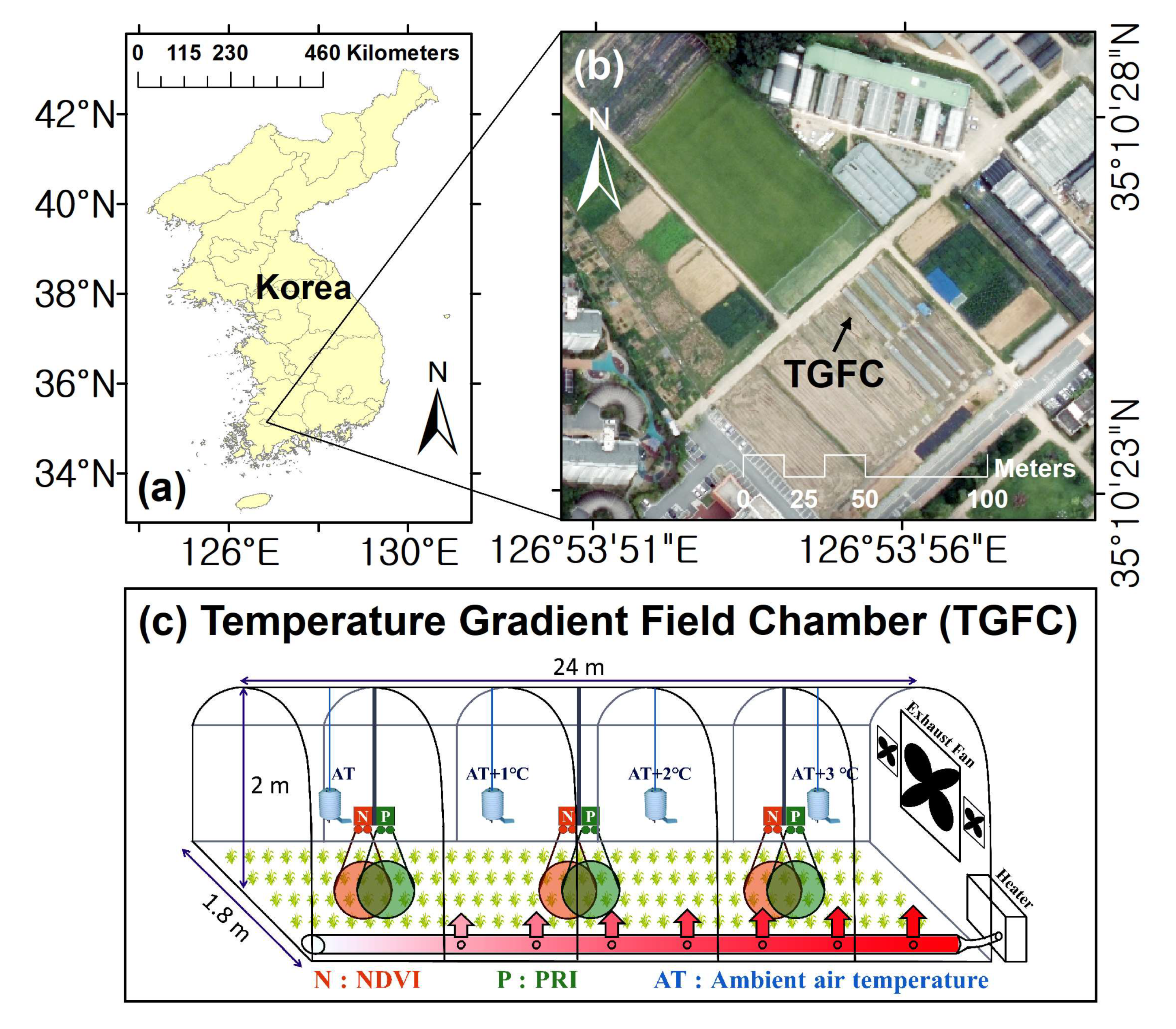
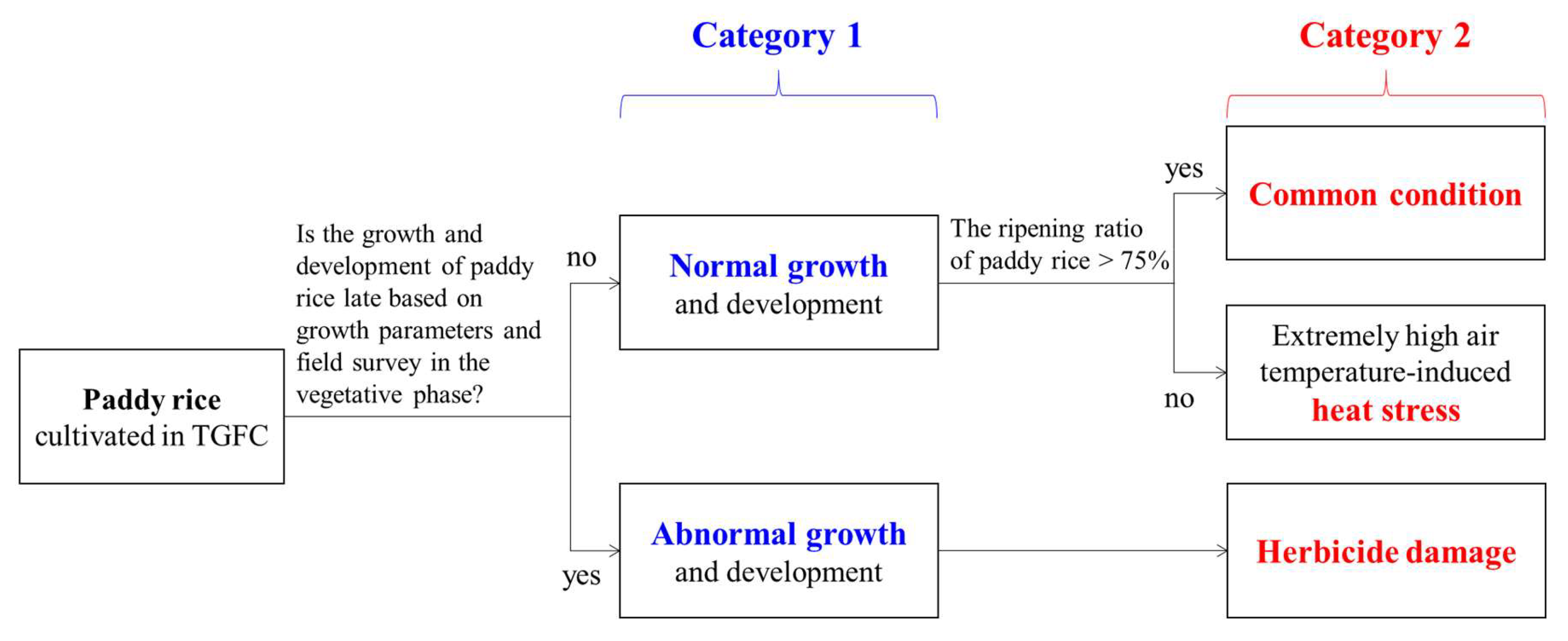
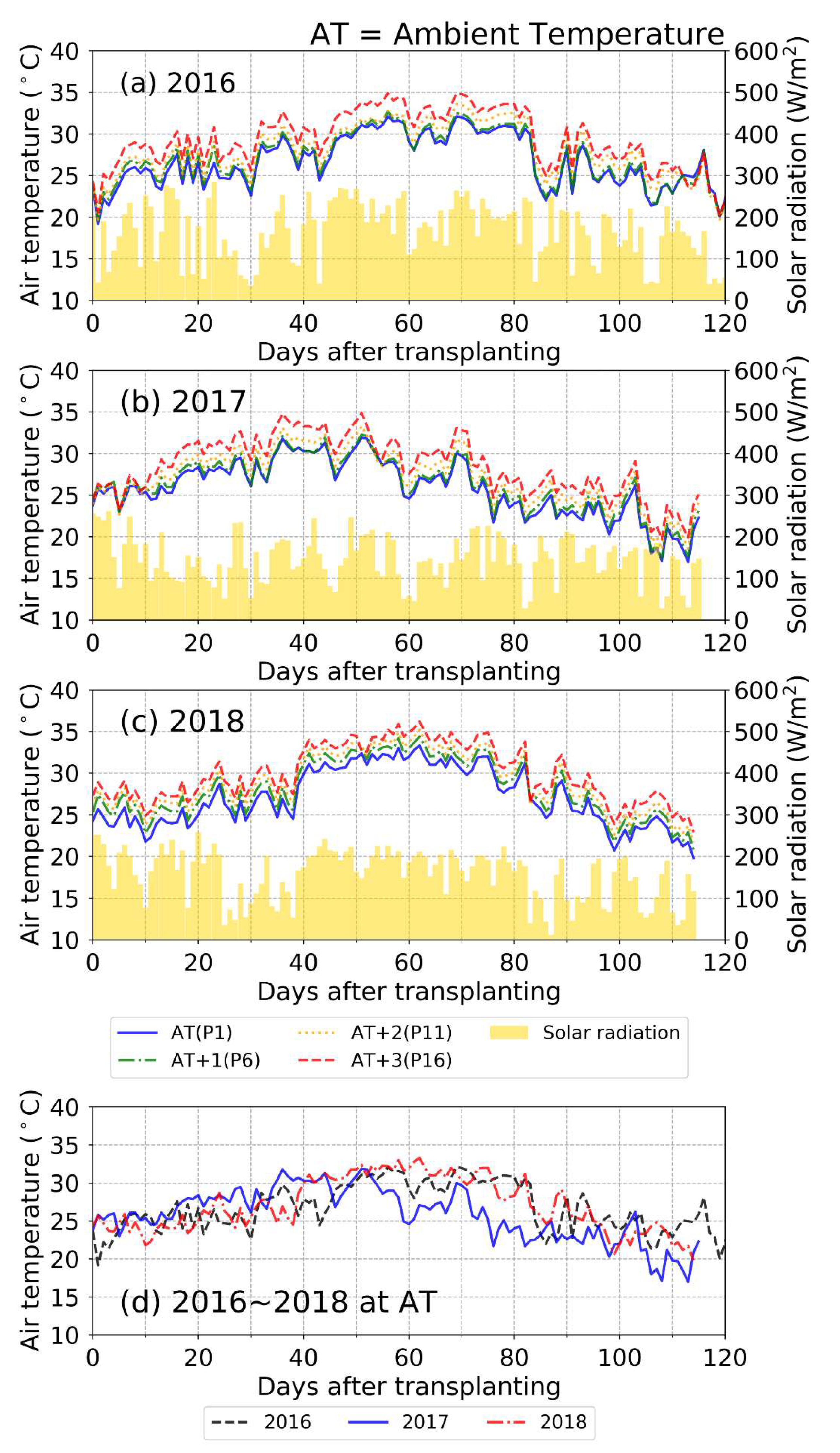
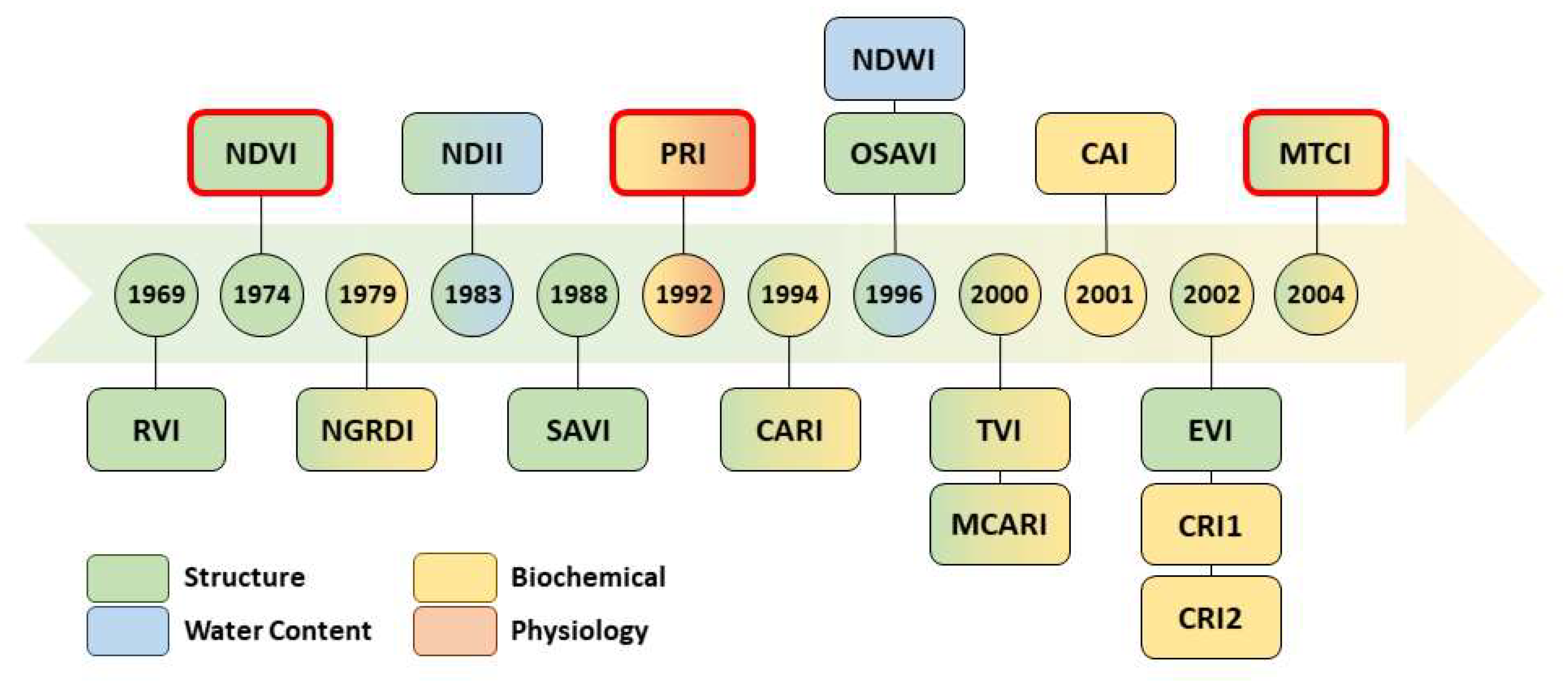

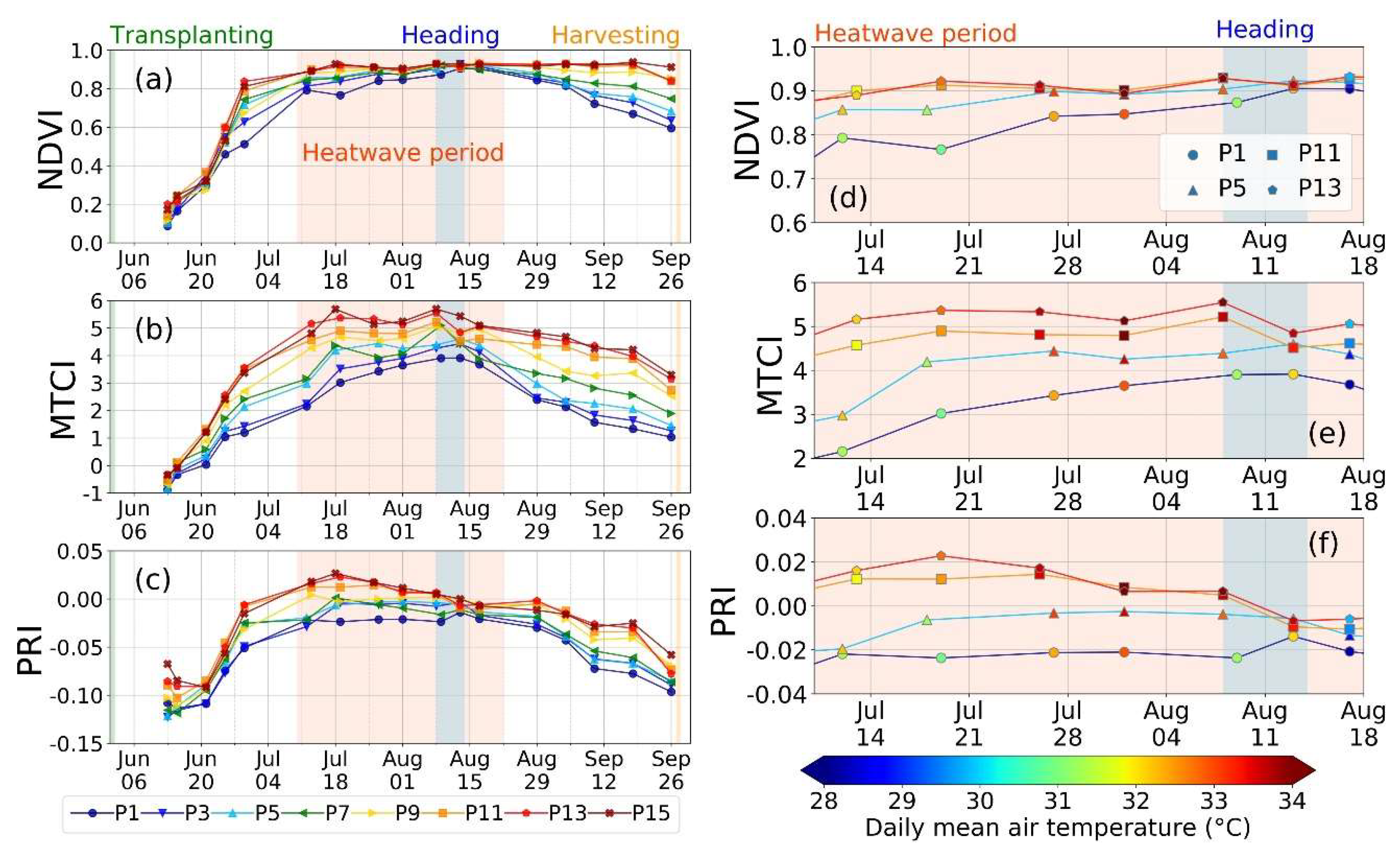


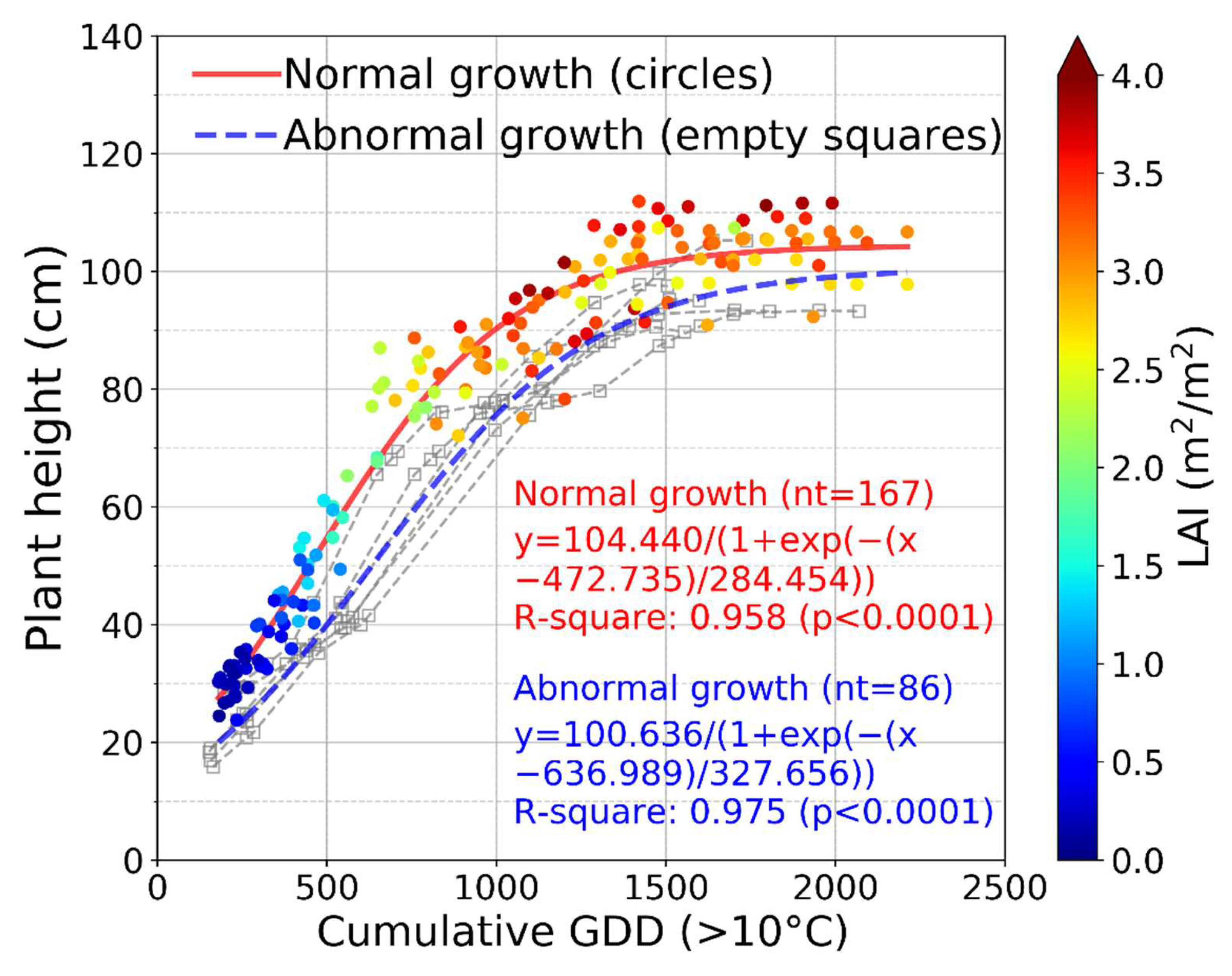
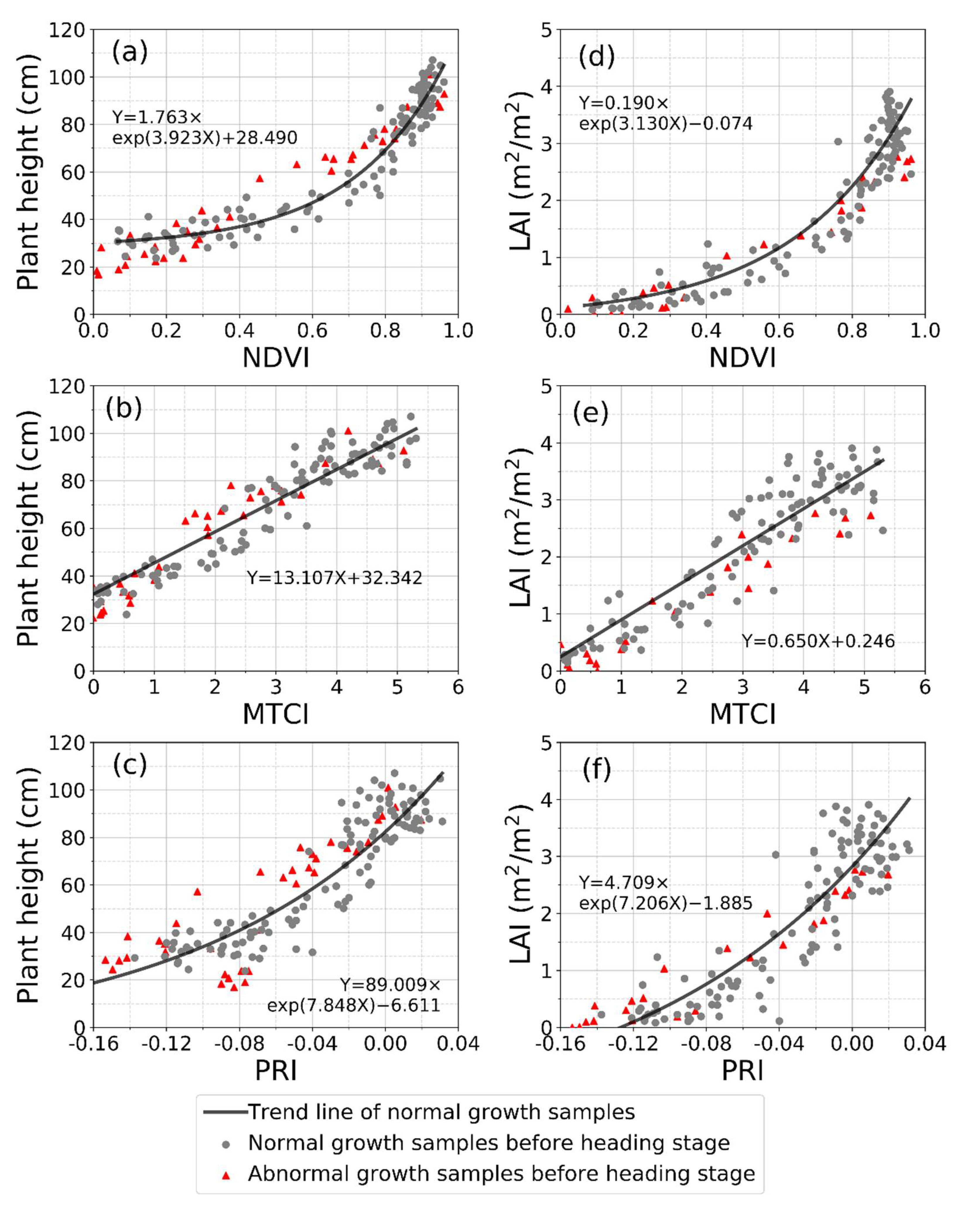


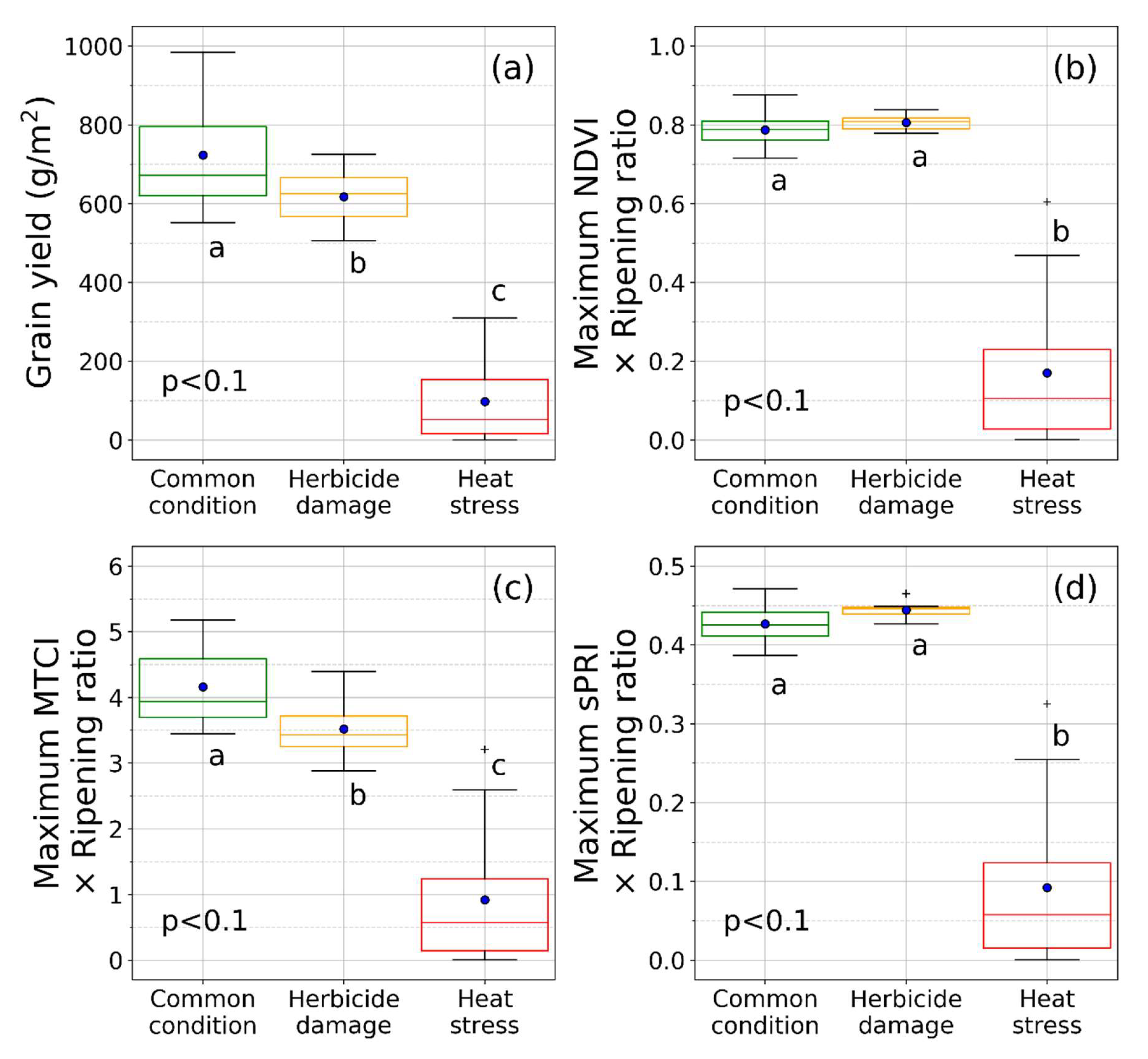
| Variables (units) | Number of Chambers (2016, 2017, 2018 years) | Number of Positions (2016, 2017, 2018 years) | Number of Measurement Data (2016, 2017, 2018 years) |
|---|---|---|---|
| Plant height (cm) | 8 (2, 2, 4) | 22 (4, 6, 12) | 227 (27, 40, 160) |
| LAI (m2/m2) | 9 (2, 3, 4) | 26 (6, 8, 12) | 279 (39, 64, 176) |
| AGDM (g/m2) | 8 (1, 3, 4) | 38 (3, 15, 20) | 120 (3, 64, 53) |
| Yield components | 8 (1, 3, 4) | 38 (3, 15, 20) | 38 (3, 15, 20) |
| Index Name (Abbreviation) | Biophysical Types | Formulations | Optical Instruments | References |
|---|---|---|---|---|
| Normalized difference vegetation index (NDVI) | Structure | (RNIR-RRed) /(RNIR+RRed) | Field spectrometer & SRS | [25] |
| MERIS terrestrial chlorophyll index (MTCI) | Structure & Biochemical | (R750-R710) /(R710-R680) | Field spectrometer | [29] |
| Photochemical reflectance index (PRI) | Biochemical & Physiology | (R531-R570) /(R531+R570) | Field spectrometer & SRS | [32] |
| Vegetation index | Data | Plant Height (cm) | LAI (m2/m2) | AGDM (g/m2) | Cumulative GDD (>10 °C) |
|---|---|---|---|---|---|
| R-Square (Function) | R-Square (Function) | R-Square (Function) | R-Square (Function) | ||
| Normalized difference vegetation index (NDVI) | Normal growth samples | 0.938 (E) | 0.903 (E) | 0.914 (E) | 0.937 (S) |
| Normal growth + Abnormal growth samples | 0.930 (E) | 0.901 (E) | 0.910 (E) | 0.892 (S) | |
| Difference | −0.008 | −0.002 | −0.004 | −0.045 | |
| MERIS terrestrial chlorophyll index (MTCI) | Normal growth samples | 0.912 (Li) | 0.886 (Li) | 0.863 (E) | 0.851 (Lo) |
| Normal growth + Abnormal growth samples | 0.915 (Li) | 0.882 (Li) | 0.816 (E) | 0.807 (Lo) | |
| Difference | 0.003 | −0.004 | −0.047 | −0.044 | |
| Photochemical reflectance index (PRI) | Normal growth samples | 0.832 (E) | 0.795 (E) | 0.784 (E) | 0.827 (S) |
| Normal growth + Abnormal growth samples | 0.817 (E) | 0.812 (E) | 0.732 (E) | 0.738 (S) | |
| Difference | −0.015 | 0.017 | −0.052 | −0.089 |
| Variables | Grain Yield (g/m2) | ||||
|---|---|---|---|---|---|
| Samples | R-square | p-value | RMSE | Equation | |
| Maximum NDVI × ripening ratio | All data | 0.869 | <0.0001 | 116.77 | Y = 893.198X − 31.928 |
| Ripening ratio > 75% | 0.002 | 0.8351 | 133.15 | Y = −158.816X + 817.234 | |
| Maximum MTCI × ripening ratio | All data | 0.912 | <0.0001 | 95.69 | Y = 177.296X − 32.928 |
| Ripening ratio > 75% | 0.481 | 0.0002 | 96.04 | Y = 142.371X + 126.796 | |
| Maximum sPRI × ripening ratio | All data | 0.861 | <0.0001 | 120.08 | Y = 1629.197X − 29.565 |
| Ripening ratio > 75% | 0.029 | 0.4375 | 131.35 | Y = −978.367X + 1114.129 | |
© 2020 by the authors. Licensee MDPI, Basel, Switzerland. This article is an open access article distributed under the terms and conditions of the Creative Commons Attribution (CC BY) license (http://creativecommons.org/licenses/by/4.0/).
Share and Cite
Ryu, J.-H.; Jeong, H.; Cho, J. Performances of Vegetation Indices on Paddy Rice at Elevated Air Temperature, Heat Stress, and Herbicide Damage. Remote Sens. 2020, 12, 2654. https://doi.org/10.3390/rs12162654
Ryu J-H, Jeong H, Cho J. Performances of Vegetation Indices on Paddy Rice at Elevated Air Temperature, Heat Stress, and Herbicide Damage. Remote Sensing. 2020; 12(16):2654. https://doi.org/10.3390/rs12162654
Chicago/Turabian StyleRyu, Jae-Hyun, Hoejeong Jeong, and Jaeil Cho. 2020. "Performances of Vegetation Indices on Paddy Rice at Elevated Air Temperature, Heat Stress, and Herbicide Damage" Remote Sensing 12, no. 16: 2654. https://doi.org/10.3390/rs12162654
APA StyleRyu, J.-H., Jeong, H., & Cho, J. (2020). Performances of Vegetation Indices on Paddy Rice at Elevated Air Temperature, Heat Stress, and Herbicide Damage. Remote Sensing, 12(16), 2654. https://doi.org/10.3390/rs12162654





